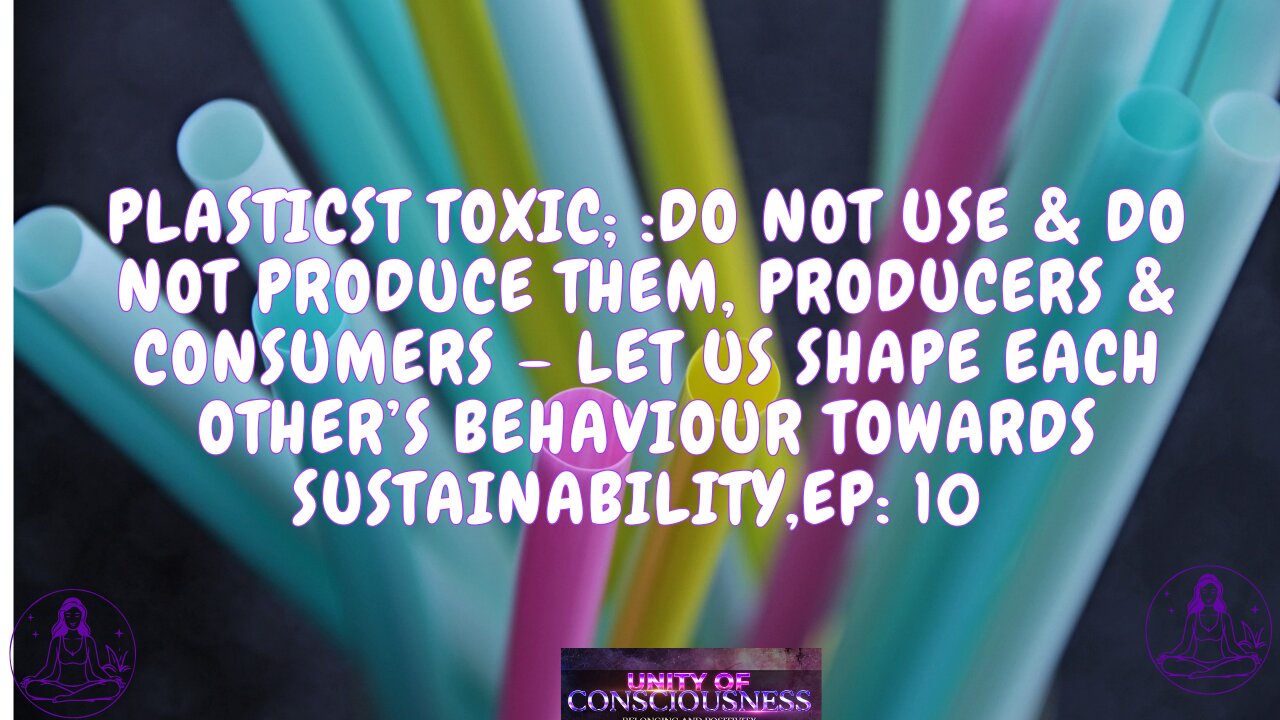Premium Only Content

Plastics are Toxic; do not Use & do not Produce them, Producers & Consumers – Let us Change; Ep 10
#ToxicPlastics #DoNotUsePlastic #DoNotProducePlastic
@unityofconsciousness475
Hi There
- You are made of: GREATNESS, PURE LOVE & LIGHT
-Link for the long video:
Plastics come in various types, distinguished by their identification numbers. Common types include PET (#1), HDPE (#2), and PVC (#3), each with distinct properties and uses. Microplastics, tiny plastic particles, are pervasive in products like cosmetics, clothing, and packaging. Items like exfoliating scrubs and synthetic fabrics release significant microplastics. The most toxic plastic, PVC (#3), releases harmful chemicals like dioxins, affecting health, ecosystems, and creating long-term financial burdens through environmental damage and healthcare costs.
--Unity of Consciousness is a YouTube channel dedicated to providing a serene and calming experience through meditation and relaxation music; wisdom for well-known spiritual people, and everyday people with their mission in finding happiness. Our channel offers a wide range of soothing melodies and compositions designed to help you unwind, de-stress, and find inner peace. We also, have dedicated ourselves to find you the best tips and experiences for happiness and spiritual growth.
--Please follow us on our channels for more relaxation music & more
- https://www.youtube.com/@unityofconsciousness475?sub_confirmation=1
-https://rumble.com/c/c-1451613
----Disclaimers:
Video is made by Unity of Consciousness via Fliki
-Text: Unity of Consciousness
-Music from Youtube Library
--References for shorts: In the Comments
References
1. Andrady, A. L., & Neal, M. A. (2009). Applications and societal benefits of plastics. Philosophical Transactions of the Royal Society B: Biological Sciences, 364(1526), 1977-1984.
2. Geyer, R., Jambeck, J. R., & Law, K. L. (2017). Production, use, and fate of all plastics ever made. Science Advances, 3(7), e1700782.
3. Hopewell, J., Dvorak, R., & Kosior, E. (2009). Plastics recycling: Challenges and opportunities. Philosophical Transactions of the Royal Society B: Biological Sciences, 364(1526), 2115-2126.
4. Thompson, R. C., Moore, C. J., vom Saal, F. S., & Swan, S. H. (2009). Plastics, the environment and human health: Current consensus and future trends. Philosophical
5. Rochman, C. M., et al. (2015). Anthropogenic Debris in Seafood: Plastic Debris and Fibers from Textiles in Fish and Bivalves Sold for Human Consumption. Scientific Reports, 5, 14340.
6. Wright, S. L., & Kelly, F. J. (2017). Plastic and Human Health: A Micro Issue? Environmental Science & Technology, 51(12), 6634–6647.
7. Galloway, T. S. (2015). Micro- and Nano-plastics and Human Health. In Marine Anthropogenic Litter (pp. 343–366). Springer.
8. Carr, S. A., et al. (2016). Transport and Fate of Microplastic Particles in Wastewater Treatment Plants. Water Research, 91, 174–182.
9. U.S. Environmental Protection Agency. (2021). "Health effects of exposure to vinyl chloride." Link
10. Plastic Pollution Coalition. (2022). "The environmental and health impacts of PVC." Link
11. World Health Organization. (2020). "Phthalates and human health." Link
--All rights reserved to: Unity of Consciousness
-Eternally Thankful
-If you are inspired, please subscribe, like and share
-
 1:05:55
1:05:55
UNITY OF CONSCIOUSNESS
1 day ago $0.02 earned777Hz, MAGIC MUSHROOMS • MIND MANIFESTING • WEALTH, ABUNDANCE, HEALTH • SEND BY UNIVERSE
241 -
 LIVE
LIVE
The Charlie Kirk Show
1 hour agoGetting Them All Confirmed + DEI in the Air | Smith, Means | 1.31.2025
10,986 watching -
 1:01:20
1:01:20
The Dan Bongino Show
4 hours agoThe Tragic Consequences Of DEI (Ep. 2413) - 01/31/2025
447K599 -
 1:03:38
1:03:38
The Rubin Report
2 hours agoTulsi Gabbard Catches Her Critics Off Guard with Her Blistering Reaction to False Smears
57.6K30 -
 1:01:33
1:01:33
Dr. Eric Berg
3 days agoThe Dr. Berg Show LIVE January 31, 2025
34.6K3 -
 1:40:05
1:40:05
Benny Johnson
2 hours agoSHOCK: New Plane Crash Video REVEALS Horrifying Truth About Tragedy | 'This was Preventable!'
58.5K63 -

LFA TV
17 hours agoTIME FOR TARIFFS! | LIVE FROM AMERICA 1.31.25 11am
21K24 -
 1:04:53
1:04:53
The Big Mig™
15 hours agoGlobal Finance Forum From Bullion to Borders
8.01K4 -
 LIVE
LIVE
The Shannon Joy Show
2 hours ago🔥🔥J6 HORROR - Live Exclusive With J6 Political Prisoner & Advocate John Strand. Now The Battle For JUSTICE Begins.🔥🔥
402 watching -
 31:18
31:18
Tudor Dixon
2 hours agoSelena Gomez's Fake Tears with Sharla McBride | The Tudor Dixon Podcast
8.05K1